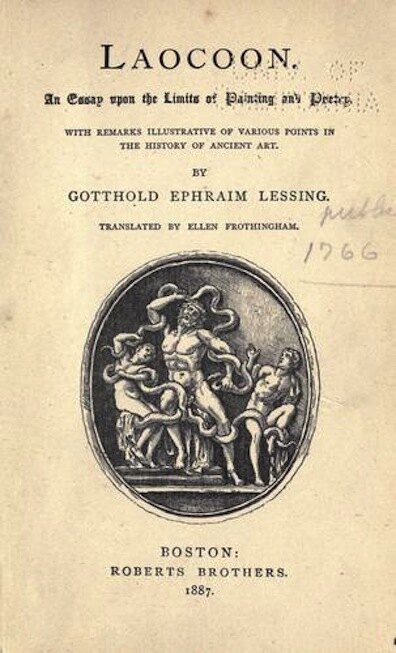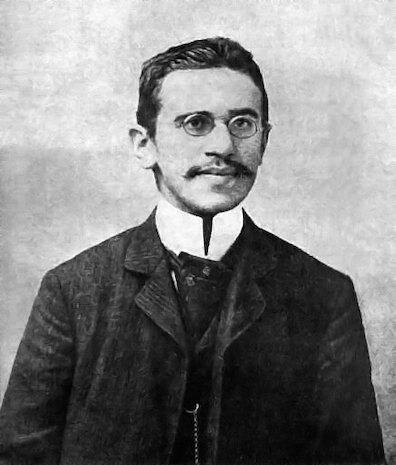Nacheinander
Nacheinander
In Brief
As Stephen walks along the beach, counting his steps with eyes closed, he thinks, "A very short space of time through very short times of space. Five, six: the nacheinander. Exactly: and that is the ineluctable modality of the audible." A moment later he imagines what would happen if he "fell through the nebeneinander ineluctably.... My two feet in his boots are at the ends of his legs, nebeneinander." The German words nacheinander (after-one-another) and nebeneinander (next-to-one-another) describe two types of sensory perception, "audible" and "visible" respectively in words that Stephen also uses here. The interactions of time and space evoked by this pair of terms are important in Joyce's art, but his thoughts about them in Proteus differ significantly from ones he had at the end of A Portrait of the Artist as a Young Man.
Read More
Theorizing about aesthetics in part 5 of A Portrait,
Stephen distinguishes between spatial and temporal arts: "An
esthetic image is presented to us either in space or in time.
What is audible is presented in time, what is visible is
presented in space." Instead of describing the two kinds of
art, he then analyzes the "esthetic image" more generally,
applying several aesthetic terms from Aquinas to define it in broad
formalist terms. But he is still thinking of the two
categories of art, and before turning to literature and
describing modes of writing that he calls lyric, epic, and
dramatic he speaks of painting and sculpture. In transitioning
from the visible arts to the audible ones he alludes to a
famous work of aesthetics by the German poet, playwright,
critic, and philosopher Gotthold Lessing: "Lessing, said
Stephen, should not have taken a group of statues to write of.
That art, being inferior, does not present the [Aquinian]
forms I spoke of distinguished clearly from one another."
Lessing's Laocoon (1766) opposes the ekphrastic tradition of likening poetry to painting, arguing instead that the two arts involve very different modes of sensory apprehension. Poetry presents things in successive moments of time while painting presents them in adjacent regions of space. It would seem, then, that when Stephen speaks of "visible" and "audible" modes of perception at the beginning of Proteus he might be returning to the aesthetic speculations he undertook in A Portrait. But in fact he shows none of Lessing's interest in separating the two modes and assigning them to different arts. His subject here is perception, and his emphasis is on the inextricable interactions of spatial and temporal modes of apprehension, which he expresses memorably in the phrase, "A very short space of time through very short times of space."
This distinction between Stephen's theorizing in A Portrait and in Proteus carries over, interestingly, into the work of identifying the source of Joyce's two German terms. For many decades, starting in the 1960s, it was widely assumed that he derived the words nacheinander and nebeneinander from Lessing's Laocoon. That attribution, first made by Fritz Senn in an article titled "Esthetic Theories," JJQ 2 (1965): 134-36, was repeated by Thornton (1968) and Gifford (1988), by authors of briefer annotations like Kiberd (1992), Johnson (1993), and Slote (2012), in an earlier version of this note (2013), and by many critics relying on one annotator or another. But in fact Joyce was reading an entirely different German-language author.As Slote and his collaborators observe in their newer and fuller Annotations (2022), the supposed allusion to Lessing always came with a caveat: "A problem, which Senn notes, is that while Lessing uses the term Nebeneinander, he generally prefers Aufeinander over Nacheinander. Senn posits that Joyce might have derived his information from some secondary source which employed the word Nacheinander" (xxxix). But it has recently become clear that Joyce was consulting a different source altogether: "Going through one of Joyce's preparatory notebooks, Wim Van Mierlo has discovered that Lessing was not at all Joyce's source for Proteus. Instead, these words came from a book by the anti-Semitic writer Otto Weininger" (xxxix). Joyce copied onto a page in one of his notebooks this sentence, along with others, from Weininger's Über die letzten Dinge: "Space...contains in juxtaposition (nebeneinander) what can only be experienced in temporal succession (Nacheinander)" (xl). The terms, Slote observes, are not unique to Weininger, but fairly common in German philosophy.
(It should be noted here that though Weininger wrote about Jewishness in highly critical ways he was himself Jewish. His reputation as simply "anti-Semitic" owes in great measure to the dishonest readings that Nazi propagandists gave to his philosophy.)
Weininger's sentence is about modes of perception rather than modes of artistic creation, just as Stephen's thoughts in Proteus are, and like this slightly older Stephen he describes space and time as mutually implicated frames of sensory experience rather than as a binary opposition. Although Stephen is not drafting aesthetic theories when he thinks of the nacheinander and the nebeneinander, his new way of thinking about spatiotemporal apprehension does hold relevance for Joyce's aesthetic designs in Ulysses. The new novel concerns itself not only with temporal arts like rhetoric, poetry, and music but also with spatial arts like sculpture, photography, and cartography. Rather than opposing the visible and the audible it weaves them together in marvelously multifarious modes of apprehending reality. The supreme expression of this approach is the tenth chapter, Wandering Rocks, where spatial and temporal modes of perception intersect. The episode is laid out on an intricately detailed fabric of space-time, and like a movie camera it jumps back and forth across points in both dimensions.

Laocoon: An Essay upon the Limits of Painting and Poetry, with remarks illustrative of various points in the history of ancient art, by Gotthold Ephraim Lessing, translated by Ellen Frothingham (1877). Source: openlibrary.org.

Portrait of the Austrian philosopher Otto Weininger, made in 1903 by an unknown photographer. Source: Wikimedia Commons.